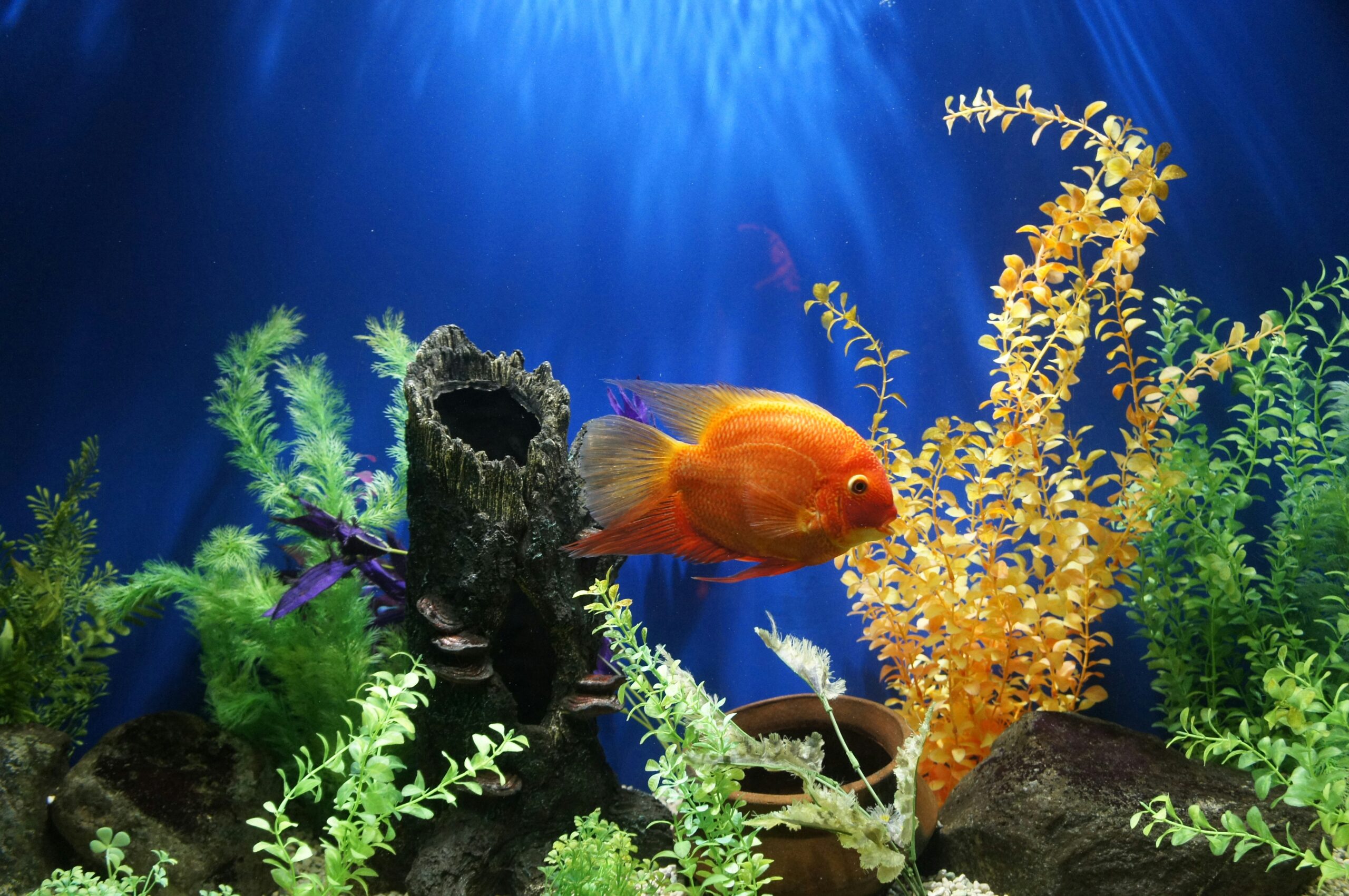Understanding the White Cotton-Like Stuff in Your Fish Tank
Having a fish tank can be a delightful addition to any home or office. However, sometimes you may notice the presence of white cotton-like stuff in your fish tank, which can be concerning. This substance is often referred to as “white fungus” or “cotton wool disease,” and it can be caused by various factors.
One of the most common causes of white cotton-like stuff in a fish tank is a fungal infection. Fungi are microscopic organisms that thrive in moist environments, making fish tanks an ideal breeding ground for them. When fish are stressed or have weakened immune systems, they become more susceptible to fungal infections. The white cotton-like stuff you see in your fish tank is actually a mass of fungal hyphae, which are the thread-like structures that fungi use to grow and spread.
Another possible cause of the white cotton-like stuff in your fish tank is a bacterial infection. Bacteria are also present in fish tanks, and certain species of bacteria can form colonies that appear as white cotton-like patches. These bacterial infections are often secondary infections that occur when fish have already been weakened by other factors, such as poor water quality or stress.
In addition to fungal and bacterial infections, the white cotton-like stuff in your fish tank could also be caused by parasites. Parasites are organisms that live off their hosts, and some species of parasites can create a cotton-like appearance on the bodies of fish. These parasites may attach themselves to the fish’s skin, fins, or gills, and their presence can lead to irritation, inflammation, and the formation of white masses.
It is important to identify the cause of the white cotton-like stuff in your fish tank in order to effectively treat the issue. If you suspect a fungal infection, there are antifungal medications available that can help eliminate the fungus and prevent its spread. For bacterial infections, antibiotics may be necessary to clear up the infection and restore the health of your fish. In the case of parasites, specific treatments designed to target the particular parasite involved may be required.
Prevention is also key in maintaining a healthy fish tank and preventing the formation of white cotton-like stuff. Regular water testing and maintenance can help ensure that water quality is optimal for your fish, reducing the likelihood of stress and susceptibility to infections. Providing a balanced diet and minimizing overcrowding in the tank can also contribute to the overall well-being of your fish.
Causes of White Cotton-Like Stuff in Fish Tanks
1. Fungal Infections: Fungal infections are a common cause of the white cotton-like stuff in fish tanks. These infections can occur when the fish’s immune system is compromised or when there are poor water conditions in the tank. Fungi are opportunistic organisms that thrive in moist environments, and fish tanks provide an ideal breeding ground for them. When the water quality is subpar, it weakens the fish’s immune system, making them more susceptible to fungal infections. Additionally, if there are dead fish or decaying organic matter in the tank, it can further contribute to the growth of fungi.
2. Columnaris Disease: Columnaris disease is another common cause of the white cotton-like growth in fish tanks. It is a bacterial infection that can affect both freshwater and saltwater fish. Columnaris disease is highly contagious and can spread quickly among fish in the same tank. The bacteria responsible for this disease, Flavobacterium columnare, thrives in water with high organic content and poor water quality. When the fish are stressed or their immune system is compromised, they become more susceptible to this bacterial infection. The white cotton-like growth seen in fish tanks with Columnaris disease is actually a biofilm formed by the bacteria, which acts as a protective barrier.
3. Poor Water Quality: Poor water quality is often a contributing factor to the growth of white cotton-like stuff in fish tanks. When the water parameters, such as pH, ammonia, nitrite, and nitrate levels, are not within the appropriate range, it can create an environment conducive to the growth of harmful bacteria and fungi. For example, high ammonia and nitrite levels can cause stress to the fish and weaken their immune system, making them more susceptible to infections. Excessive nitrate levels can lead to algae blooms, which can compete with the fish for oxygen and create an imbalanced ecosystem. Additionally, poor water circulation and inadequate filtration can also contribute to the accumulation of organic waste, providing a food source for bacteria and fungi to thrive.
4. Overcrowding and Stress: Overcrowding of fish in a tank can lead to stress, which weakens their immune system and makes them more prone to infections. When fish are overcrowded, there is an increased amount of waste produced, and the filtration system may not be able to keep up with the demand. This can result in poor water quality, creating an ideal environment for the growth of white cotton-like stuff. It is important to provide enough space for each fish to swim freely and establish territories to minimize stress and promote a healthier environment.
5. Lack of Maintenance: Neglecting regular tank maintenance can also contribute to the growth of white cotton-like stuff. If the tank is not properly cleaned and the water is not regularly changed, it can lead to a buildup of organic waste and harmful bacteria. Uneaten food, fish waste, and decaying plants can all contribute to the deterioration of water quality. Regular water changes, cleaning of filters, and removal of debris can help prevent the accumulation of waste and maintain a healthy environment for the fish.
Steps to Get Rid of the White Cotton-Like Stuff
1. Quarantine Affected Fish: If you notice any fish with signs of illness or the white cotton-like growth, it is crucial to quarantine them immediately. This will help prevent the spread of any potential infections to other healthy fish in the tank.
2. Test Water Parameters: Use a reliable water testing kit to check the parameters of your fish tank water. Ensure that the pH, ammonia, nitrite, and nitrate levels are within the appropriate range for your fish species.
3. Perform Regular Water Changes: Regular water changes are essential to maintain good water quality in your fish tank. Aim to change approximately 25% of the water every week to remove any accumulated toxins and pollutants.
4. Clean and Disinfect Tank Decorations: Remove any tank decorations, such as rocks, plants, or ornaments, and clean them thoroughly. Use a mild bleach solution or a fish-safe disinfectant to kill any bacteria or fungi that may be present.
5. Treat the Tank with Medication: Depending on the cause of the white cotton-like growth, you may need to treat the tank with appropriate medication. Consult with a veterinarian or a knowledgeable fish store professional to identify the specific medication required for your situation.
6. Improve Filtration and Aeration: Proper filtration and aeration are crucial for maintaining a healthy fish tank environment. Ensure that your filter is functioning correctly and providing adequate water circulation. Consider adding an air pump or adjusting the existing one to increase oxygen levels in the tank.
7. Avoid Overfeeding: Overfeeding can lead to excess waste and poor water quality, creating an ideal environment for the growth of harmful bacteria and fungi. Feed your fish the appropriate amount of food based on their size and species, and remove any uneaten food after a few minutes.
8. Monitor Water Temperature: Maintaining the correct water temperature is essential for the overall health of your fish. Make sure the water temperature is appropriate for the specific fish species you have. Sudden fluctuations in temperature can stress the fish and weaken their immune system, making them more susceptible to infections.
9. Introduce Beneficial Bacteria: Adding beneficial bacteria to your fish tank can help establish a healthy biological balance. These bacteria help break down waste and reduce the risk of harmful bacterial or fungal growth. You can purchase beneficial bacteria supplements from pet stores or use products that contain live bacteria cultures.
10. Consider UV Sterilization: UV sterilizers use ultraviolet light to kill bacteria, viruses, and other pathogens in the water. Installing a UV sterilizer in your fish tank can help prevent the spread of infections and reduce the likelihood of the white cotton-like growth recurring. However, it is important to follow the manufacturer’s instructions and ensure that the UV sterilizer is compatible with your tank size and fish species.
11. Maintain a Stress-Free Environment: Stress can weaken the immune system of fish, making them more susceptible to diseases. Ensure that your fish tank provides a stress-free environment with adequate hiding places, suitable tank mates, and a consistent lighting schedule. Avoid sudden changes in water conditions or aggressive handling of the fish.
12. Regularly Monitor and Take Action: Even after following all the necessary steps, it is important to regularly monitor your fish tank for any signs of illness or abnormal behavior. If you notice any recurrence of the white cotton-like growth or other health issues, take immediate action to address the problem. Consult with a veterinarian or a fish expert for further guidance and treatment options.
Preventing the Recurrence of White Cotton-Like Stuff
1. Maintain Good Water Quality:
Regularly test and monitor the water parameters in your fish tank. Keep the pH, ammonia, nitrite, and nitrate levels within the appropriate range for your fish species. This will help ensure a healthy environment for your fish and reduce the likelihood of diseases and infections.
2. Quarantine New Fish:
Before introducing any new fish to your tank, it is essential to quarantine them for a few weeks. This practice allows you to observe the new arrivals for any signs of illness or parasites. By keeping them separate from your established tank, you can prevent the introduction of potential pathogens that could harm your existing fish population.
3. Avoid Stressing Your Fish:
Stress can weaken a fish’s immune system and make them more susceptible to infections. To minimize stress, provide a suitable environment with proper hiding spots, appropriate tank mates, and a consistent feeding schedule. Additionally, ensure that the water temperature and quality are stable, as sudden changes can stress your fish.
4. Maintain a Clean Tank:
Regularly cleaning your tank and its components is crucial in preventing the recurrence of white cotton-like stuff. Clean the filter regularly to remove any debris or buildup that could harbor harmful bacteria or fungi. Vacuum the gravel to remove excess waste, and clean the decorations to eliminate any potential sources of infection. It is also important to remove any uneaten food promptly to prevent it from decomposing and polluting the water.
5. Observe and Monitor Your Fish:
Pay close attention to your fish’s behavior and appearance. Regularly observe them for any signs of illness, such as lethargy, loss of appetite, or unusual growths. If you notice any abnormalities, take immediate action to address the issue. This may involve isolating the affected fish, adjusting water parameters, or seeking advice from a veterinarian or experienced fishkeeper.
Conclusion
The presence of white cotton-like stuff in your fish tank can be a sign of fungal, bacterial, or parasitic infections. It is important to identify the cause and seek appropriate treatment to prevent further harm to your fish. By maintaining a clean and well-balanced environment, you can help ensure the health and longevity of your aquatic pets.

